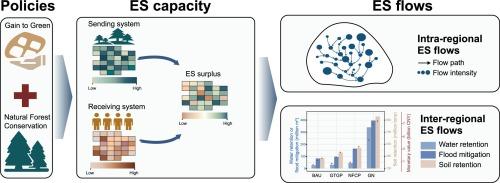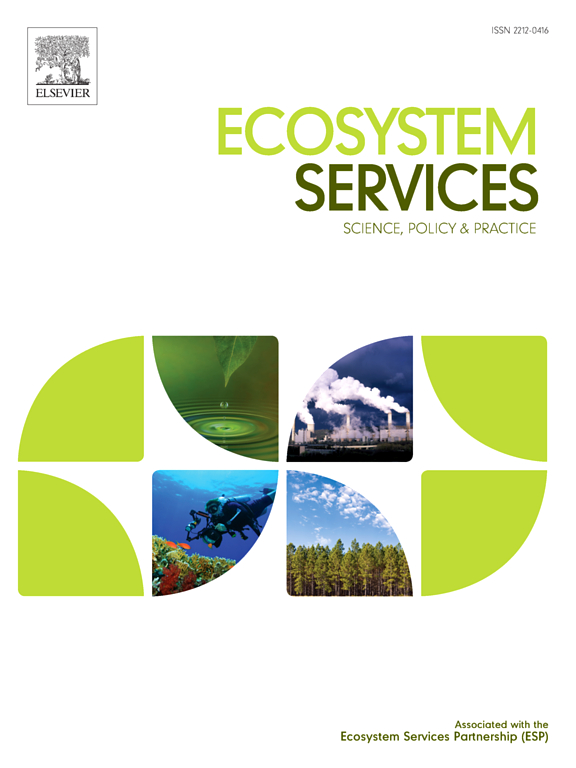Effects of ecological restoration projects on ecosystem services flows
IF 6.6
2区 环境科学与生态学
Q1 ECOLOGY
引用次数: 0
Abstract
Conserving and managing natural capital require an in-depth understanding of the complex flow dynamics of an ecosystem service (ES) under different policy contexts. However, little is known about how ecological restoration projects affect ES flows, impairing the identification of sustainable management and decision choices. Here, we addressed this knowledge gap and reported on the effects of Natural Forest Conservation Project (NFCP) and Grain to Green Project (GTGP), two of the largest restoration projects worldwide, by taking the Blank River Basin of Shaanxi province, China, as a case study. We found that the inter-regional ES flows under the joint implementation of these two projects increased by 10.1 % (water retention), 5.9 % (flood mitigation) and 7.7 % (soil retention), in relation to the sum of benefits produced by the two projects separately. Higher flow intensity was observed for the three services between June and September compared to those in other months. The effects of different projects showed a spatial heterogeneity across the basin, with major increases of intra-regional ES flows observed in the southern region. Quantitative analyses revealed higher intra-regional ES flows with more synergistic areas for all services when GTGP and NFCP were jointly implemented in relation to their separate enforcement. Our findings highlight the importance of considering the integrated effects of multiple projects in systematic conservation planning aiming to improve ecosystem benefits to people both locally and across distances.

生态恢复项目对生态系统服务流的影响
保护和管理自然资本需要深入了解不同政策背景下生态系统服务(ES)的复杂流动动态。然而,人们对生态恢复项目如何影响生态系统服务流知之甚少,从而影响了可持续管理的确定和决策选择。在此,我们针对这一知识空白,以中国陕西省白浪河流域为例,报告了天然林保护项目(NFCP)和粮改绿项目(GTGP)这两个全球最大的生态恢复项目的影响。我们发现,与两个项目分别产生的效益总和相比,在这两个项目的联合实施下,区域间环境服务流量分别增加了 10.1%(水源涵养)、5.9%(洪水缓解)和 7.7%(土壤保持)。与其他月份相比,6 月至 9 月期间三种服务的流量强度更高。不同项目对整个流域的影响具有空间异质性,南部地区的区域内环境服务流量显著增加。定量分析显示,当 GTGP 和 NFCP 联合实施时,与单独实施相比,区域内 ES 流量更高,所有服务的协同区更大。我们的研究结果突显了在系统性保护规划中考虑多个项目综合效应的重要性,这些规划旨在改善当地和远距离人群的生态系统效益。
本文章由计算机程序翻译,如有差异,请以英文原文为准。
求助全文
约1分钟内获得全文
求助全文
来源期刊

Ecosystem Services
ECOLOGYENVIRONMENTAL SCIENCES&-ENVIRONMENTAL SCIENCES
CiteScore
14.90
自引率
7.90%
发文量
109
期刊介绍:
Ecosystem Services is an international, interdisciplinary journal that is associated with the Ecosystem Services Partnership (ESP). The journal is dedicated to exploring the science, policy, and practice related to ecosystem services, which are the various ways in which ecosystems contribute to human well-being, both directly and indirectly.
Ecosystem Services contributes to the broader goal of ensuring that the benefits of ecosystems are recognized, valued, and sustainably managed for the well-being of current and future generations. The journal serves as a platform for scholars, practitioners, policymakers, and other stakeholders to share their findings and insights, fostering collaboration and innovation in the field of ecosystem services.
 求助内容:
求助内容: 应助结果提醒方式:
应助结果提醒方式:


